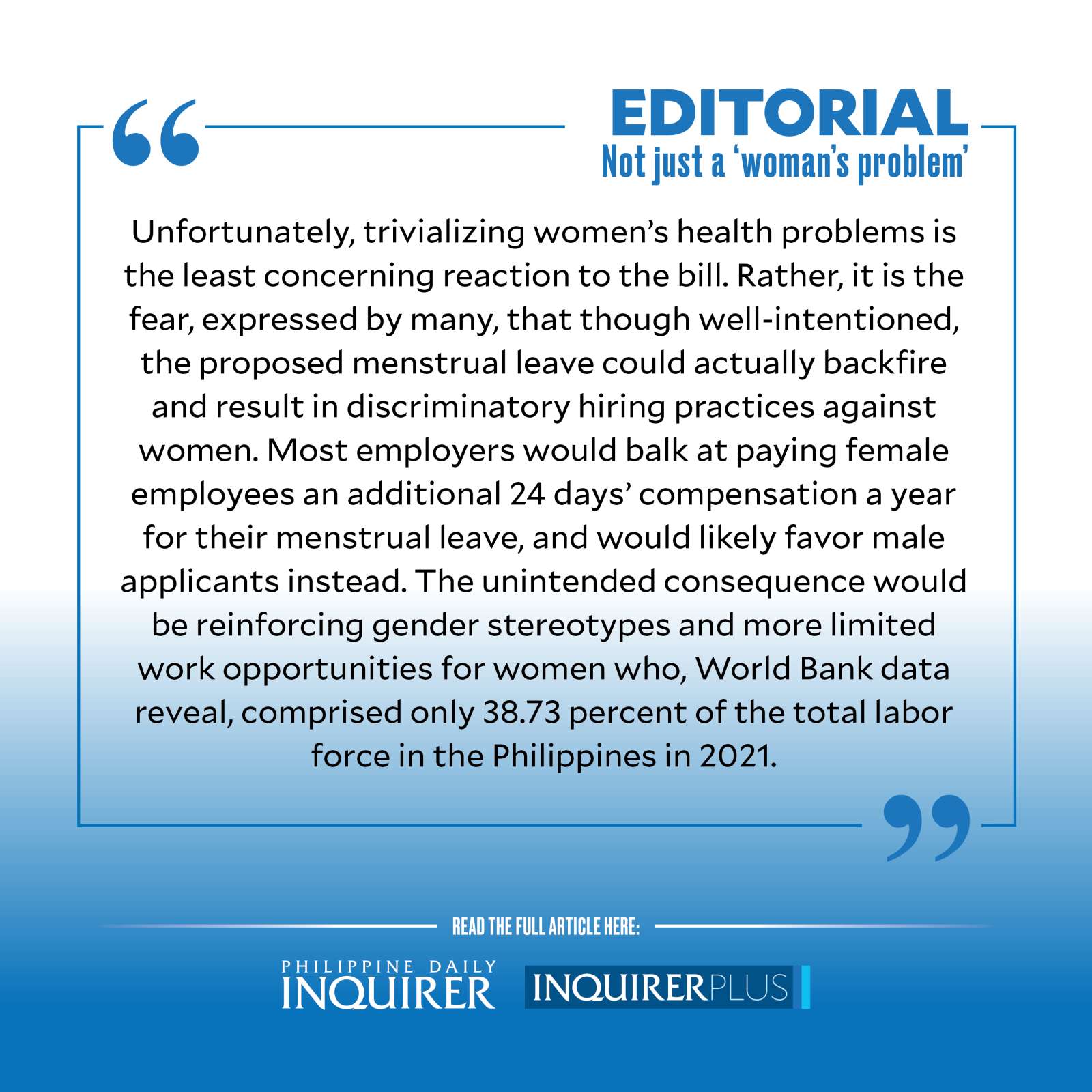Not just a ‘woman’s problem’
Some women euphemistically call it “red letter days,” but for those who suffer dysmenorrhea or menstrual cramps, the monthly period is a much-dreaded occurrence. According to the National Library of Medicine, 16 to 91 percent of women of reproductive age suffer from dysmenorrhea, with severe pain in up to 29 percent of the women studied. The pain, which ranges from mild discomfort to excruciating, is caused by the uterus contracting to shed its lining, and may be accompanied by nausea and migraines.
So debilitating can this monthly affliction be especially among women workers, that Gabriela party list Rep. Arlene Brosas last week filed House Bill No. 7758 or the Menstrual Leave Act, that would “provide women with the flexibility and support they need to manage their reproductive health without the fear of negative consequences such as losing pay, falling behind in work, or facing disciplinary action.” The bill requires employers in the public and private sectors to provide female employees a maximum of two days paid leave every month to help them cope with menstrual difficulties without added pressure from the workplace.
As expected, the proposed support for women’s reproductive-related malady provoked extreme reactions, notably from former senator Panfilo Lacson who tweeted: “Next time, a legislative measure will be filed mandating menopause and andropause allowances to increase the testosterone levels of workers.” He was promptly called out by netizens for being “insensitive,” “lacking empathy,” and being “misogynist.”
Unfortunately, trivializing women’s health problems is the least concerning reaction to the bill. Rather, it is the fear, expressed by many, that though well-intentioned, the proposed menstrual leave could actually backfire and result in discriminatory hiring practices against women. Most employers would balk at paying female employees an additional 24 days’ compensation a year for their menstrual leave, and would likely favor male applicants instead. The unintended consequence would be reinforcing gender stereotypes and more limited work opportunities for women who, World Bank data reveal, comprised only 38.73 percent of the total labor force in the Philippines in 2021.
According to the Employers Confederation of the Philippines (Ecop), the projected increased pay for women workers is an economic burden that most companies can ill afford, as they are still recovering from the effects of the pandemic lockdown and coping with straitened economic prospects. Small, medium, and micro enterprises might even go out of business, the group added. Further, given the country’s at least 15 nonworking holidays a year, companies are bound to suffer loss of productivity even more, especially in female-dominated industries, an Ecop official noted. He even ventured an unpopular but realistic thought: How do we even prove that the woman worker is really in menstrual distress and thus entitled to the paid leave?
These are valid concerns that the bill’s proponents must address if the proposal were to gain wide support. True, our Asian neighbors Taiwan, South Korea, Japan, and Indonesia have incorporated menstrual leave into their labor laws, but how do they make it work? Can we adopt the same mechanics locally?
As in Indonesia, local companies have suggested that women’s menstrual leave be counted as part of their total leave entitlement which, according to Article 95 of the Philippine Labor Code is five days of annual service incentive leave for those who have rendered at least a year of service. Most private companies however offer regular employees 13 to 18 paid vacation leave and a maximum of 15 days sick leave a year, with unused leaves convertible to cash. Why not file for a sick leave instead, an Ecop official has suggested.
Japan’s menstrual leave meanwhile does not require companies to provide extra pay for women who choose to work during their period, unlike in South Korea where female employees are assured additional pay if they do not avail of this monthly benefit. Taiwan gives women workers three days of “menstrual leave” per year which are added to their 30 days of “common sick leave,” for a total of 33 days of “health-related leaves” a year. Spain, in February this year, became the first European country to entitle women workers to a three-day menstrual leave every month to be paid by the public social security system.
Closer to home, legislators can check out the initiative of La Union’s provincial government and Tangalan municipality in the second district of Aklan that created Menstruation Day using an executive order and a municipal ordinance, respectively. In both instances, female employees are allowed to work from home two days a month during their period and are provided menstrual kits in an output-oriented arrangement approved by the Civil Service Commission.
With local governments showing the way, can the national government do any less?





















